More information about this website & why it was created can be found by visiting this website's "front" pages (link opens in a new window).
As part of a nation's transport system, the railways are the backbone. Ranging from luxury high-speed InterCity expresses to street compatible trams and streetcars, the railways are the most efficient and environmentally beneficial form of travel between and within urban areas. They are also a popular way to travel - experience has shown that rail is the most successful modal choice for enticing people to travel by public transport.
The existence of the railways enhances individual freedom by empowering travellers to choose "how to travel" without reducing the options for people who do not drive. Investing in railways is a cost effective alternative to creating extra road capacity which experience has shown only serves to create further demand for yet more road capacity. In this way even people who do not use the trains still benefit - if only because the more people who travel by train, the emptier the roads will be for them.
High speed InterCity services provide an alternative to air travel and a faster, less stressful alternative to driving. Railways are excellent at safely moving large numbers of people quickly over long distances, carrying as much as 75% of Britains long distance InterCity traffic.
Overnight services offer similar benefits to less time conscious travellers, or for those on longer journeys where the combination of travel and 'hotel' is preferable to long check-in times, late night / early morning flights and long transfer journeys.
Where available Motorail combines the advantages of regular passenger services with, at the destination, the freedom to use one's own car to roam at will - this is especially useful when visiting remote areas not served by public transport.
Within urban areas the rôle of the railways is legendary; over 78% of morning peak travel into London is by train (mainline, Underground, Docklands Light Railway) and without these services London would cease to be a viable city. The roads simply could not cope!
Rural services form additional functions as social services linking many of the remoter communities and acting as lifelines in areas often poorly served by roads, enhancing access to jobs and services and thereby improving the quality of life for the rural communities. It is not surprising therefore that these rural communities attach significant intrinsic value to rural lines and the permanent transport corridor connection they provide.
As well as providing access to the rail network, rural stations can also serve as important transport interchange hubs for local public transports (particularly bus services) aiding in turn route viability by creating necessary concentrations of demand.
Particularly at weekends and holiday periods 'townies' also benefit from rural lines and the improved access they provide to rural areas for leisure and tourism - for instance to seaside towns and environmentally sensitive areas such as our coastlines, National Parks and the Scottish Highlands. Where appropriate rural stations can be developed into hubs for rural tourism, with tourist information, local hotel accommodation and cycle hire arranged / provided at the station. By virtue of their scenic quality some rural lines are tourist attraction in their own right; in this way the tourists generate income which both benefits the local economy and helps sustain otherwise (possibly) uneconomic rural services.
People who live near rail lines have found that no matter how busy the rail line the intermittent noise tends to make them better neighbours than roads, where the noise of the traffic is an incessant drone - except during traffic jams!!! This applies whether the trains are locomotive-hauled or multiple-unit passenger carriages although experience has shown that electric trains are generally quieter than diesels, and trains which are coasting quieter than those which are accelerating.
Whilst it is true that overall the railways carry only a percentage of total British land passenger travel this figure includes many journeys which would not be possible any other way, plus it must be remembered that the many road (etc.,) journeys would be in areas where railways do not (or no longer) exist and therefore roads are the only available option. In fact there exists a massive pent-up demand for rail travel - since 1995 passenger numbers have soared by 33% and in 2003 the British people made one billion passenger journeys by train.
In 2004 passenger numbers increased by one million journeys per week so that by the end of the year overall rail patronage had risen to one billion 500 million journeys, this being the highest number of passenger journeys since 1959 - when the network was almost twice the current size. By 2006 the number of passengers had soared to 1.15billion - up by 6.7% on the previous year and the highest in 60 years.
By 2012 the figure had reached 1.46 billion passenger journeys, and were rising at about 7.8% per year.
How many more journeys would there have been if the option of travelling by train had been a viable alternative choice?
Page Index
Direct links to other Railways pages...
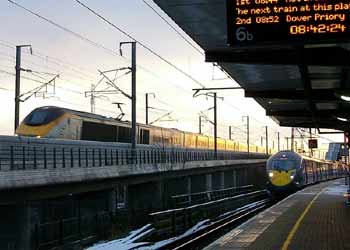 |
 |
|
| 186mph (300km/h) Eurostar train on the High Speed Line passes an arriving Southeastern "Javelin" high speed train. Although designed for 140mph (225km/h) the Javelin trains
only normally exceed 125mph (201km/h) when running late.
This image was kindly supplied by Peter Skuce. |
InterCity and underground trains pass at South Kenton station in north London. | |
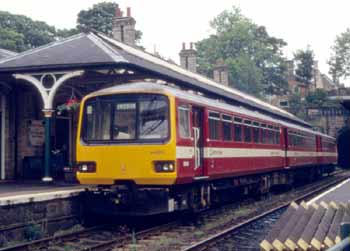 |
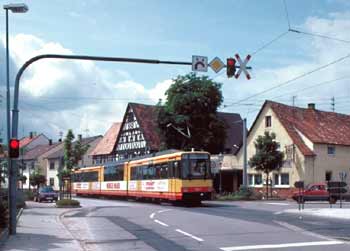 |
|
| Local train at Knaresborough station, North Yorkshire. | An inter-urban light rail service passing through the village of Linkenheim, near Karlsruhe, SW Germany. | |
Freight TrainsMost of the references to railways on this site refer to passenger services, however we must not forget the rôle of the freight train. Indeed freight is what the railways were originally invented for - to carry heavy loads of coal and other minerals across Britain in far greater quantities and at far higher speeds than was possible with the canals. 175 years later the railways still excel at this, although nowadays the competition mostly comes from the roads - and not inland waterways. Amongst the advantages of more railfreight are:-
Much of the above information was sourced from the Freight on Rail http://www.freightonrail.org.uk/ A survey conducted in December 2003 for the Rail Freight Group http://www.rfg.org.uk/ |
||
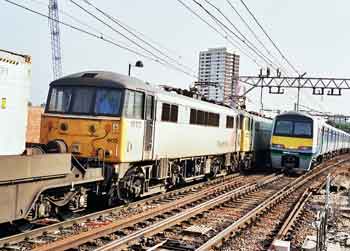 |
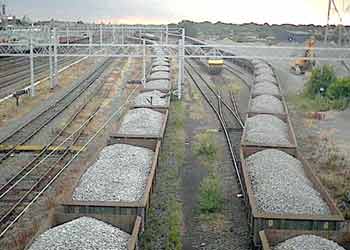 |
|
| In Britain rail privatisation means that too often passenger and freight services have to compete for space on the tracks - in this instance the freight train has stopped to allow the passenger train to go first. This image was taken at Stratford, in East London, where in the name of a new East - West rail service the government is planning to introduce regulations which could affectively banish the freight trains from a series of key junctions. |
Each mineral freight train such as these can help remove as many as 120 lorry journeys from our roads!
Image & license: Wikipedia encyclopædia. Public domain. http://commons.wikimedia.org/wiki/File:Wagons_550.jpg. |
|
Freight train drivers are skilled professionals...Freight train drivers are highly skilled personnel who before being allowed to operate a train along a section of track must spend many hours learning both the characteristics of the specific routes they will be using (ie: location of signals, junctions, speed limits, bridges / tunnels, etc) and all aspects of the different types of trains they will be driving (ie: proper function of every switch, location and use of safety features, etc.) Then they must take a tough examination. ... whereas HGV drivers are sometimes virtually unskilledThis is in stark contrast to the situation on the roads where anyone with a heavy goods vehicle driving license can use any road, in any weather condition, no matter how familiar they are (or are not) with that road. This causes problems when, all too often, they try to pass under a bridge too low for the vehicle they are driving. "Bridge bashing" is a nuisance because despite being the innocent party rail services must be halted until an engineer inspects the bridge and declares it safe - ie: neither it nor the railway tracks have been shifted out of alignment, and the abutments / supports can still carry the weight of the passing trains. Although bound by safety regulations that require them to keep stopping for rest periods it is not uncommon for long distance juggernaut drivers to nod off (ie: fall asleep) while driving, causing danger to both themselves and other road users. Admittedly this is not always their fault - as it is frequently the situation that their employers demand that they adhere to delivery schedules which are impossible to follow whilst observing the appropriate driving hours etc; regulations. |
||
Rigged economicsPerhaps the biggest hurdle to be faced by railfreight operators is that compared to road freight operators they do not compete in an equal market (or, to put it another way, there is an unlevel playing field). As with all other forms of road transport roadfreight is usually costed on the basis of the 'marginal' costs of the driver plus road fuel. The cost of the vehicles, maintenance, road-tax etc is rarely taken into account - and even when they are then only the direct costs are noted. The cost of highway maintenance is usually ignored - primarily because "the government" pays for it. As a contrast railfreight charges include all the up-front charges, which includes staff & fuel (etc) as well as the track access charges - aka the railway equivalent of road pricing. Reducing the number of heavy lorries on our roads would also lower the significant financial burden of expensive repairs caused by them. Road freight taxes never cover the true cost of road maintenance, and when governments try to raise taxes to realistic levels the truckers often go on strike - blocking roads and rail lines alike as they hold their fellow citizens and unfortunate foreigners to ransom! (This problem is not unique to France - at the time of writing similar is happening in Chile, South America). |
||
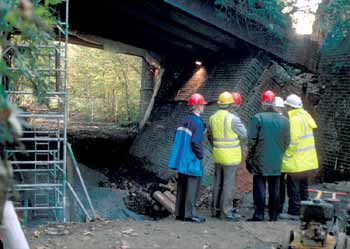 |
 |
|
| When roads are forced to carry heavy goods traffic for which they were not designed then structural failures can occur! Collapsed bridge on former railway in Muswell Hill, London. (This line was originally meant to become part of London Underground's Northern Line, even appearing on Underground maps, but in 1954 was closed instead). | Because Switzerland is not in the EU it can set its own transport policies and say 'no' to fume belching heavy lorries using its roads and polluting its countryside. Just part of a very long freight train seen travelling through Flüelen on the St Gotthard route across the Swiss Alps. |
|
 |
 |
|
The fastest, safest and most environmentally sound way for heavy lorries and juggernauts to travel is by train - either with the cabs (above left) or as unaccompanied trailers
(above right). Trains such as these operate on several routes across Europe - the trains shown here (at Flüelen on the St Gotthard route across the Swiss Alps) would be linking Germany with Italy. This would
partly be because the Swiss do NOT want them on their roads(!) but also because it is much more cost effective than driving up and over the Alpine mountains. Similar trains serve other routes too - for instance through
Austria.
Maybe these images could provide the inspiration for a cheaper alternative (for us in Britain) to widening the M1, M6, M25, M62 etc; motorways - with trains using a reopened and electrified Great Central route along the spine of England (including the Woodhead section over the Pennines). It might even prove possible to transfer some freight trains from the currently oversubscribed trunk rail routes which are still extant - thereby leaving more "paths" for more InterCity and local passenger services along those routes too. To better see that the unaccompanied trailers in the view above right have road wheels click that image for a larger version
Road damage; its a 'weighty' matterIn Britain the maximum weight limit for juggernauts used to be 41 tons but under pressure from the EU that has had to be raised to 44 tons. Before the limit went up however, many roads and (especially) bridges needed strengthening to accept the greater weight. (Yet another burden on the British taxpayer!) According to the Design Manual for Roads and Bridges which was published by the Highways Agency in 1994, a 40 tonne, 5 axle lorry causes over 10,000 times more damage to road surfaces than an average car. Further research in 2006 (by the Freight on Rail group) found that HGVs are up to 160,000 times more damaging to road surfaces than the average car; therefore some of the heaviest road repair costs are almost exclusively attributable to the heaviest vehicles. Yet despite this our govt. still let the EU impose even heavier lorries on us. As a contrast the Swiss, realising the damage caused by heavy lorries to their roads, have a maximum weight limit of just 28 tons - instead they require heavier lorries to travel by train. The idea may sound
weird but the concept is already well proven in both Europe and North America. As the image above left shows, the juggernauts travel on special flat-bed wagons and their drivers travel in attached
passenger carriages. The Swiss are so keen on railfreight that to increase capacity of their rail system they are investing in (ie: building) several 'base' level tunnels through the Alps as this will considerably
reduce journey times compared to services over the present-day tortuous routes which require trains to climb up one side of the mountains and then down the other. The first of these opened in June 2007. Further
information on AlpTransit can be found on this page at the free online "Wikipedia" encyclopædia http://en.wikipedia.org/wiki/Alptransit
To further encourage railfreight the Swiss also have many factories connected to their rail system. At one time many British factories were similarly connected to our rail system. To encourage more railfreight here in Britain we need to...To encourage more railfreight here in Britain we need to reconnect more of our factories to our rail system, to help achieve this there is a need for land-use planning criteria which encourages companies to think rail, to show willing the British government should stop talking and take action - for starters it could reinstate the rail freight grants which were suddenly cancelled in 2002 after 25 years of successfully taking lorries off our roads. There is also a need to ensure that the railway infrastructure serving our ports (sea, air) is capable of taking the required railway traffic levels - plus that there in a national network of interconnected core routes serving these ports. This means that for some locations the network capacity may need boosting, with extra tracks, signalling which allows trains to run more frequently, stronger physical infrastructure for longer & heavier freight trains, gauge enhancement so that physically larger Continental trains can use more of the network (and container trains carrying the 9' 6" deep sea containers), and possibly even line reopenings / other diversionary routes to relieve on-rail congestion in major conurbations. The electrification of all core freight routes would also provide many benefits - to avoid duplication this topic is more fully explored on a dedicated railway electrification page. To further reduce the numbers of large HGV's on our roads there is also a need for a network of local transhipment points where long distance railfreight could be switched to roads for final local delivery - perhaps by electric vans. In some areas such local distribution centres could become truly multi-modal by being located close to waterways / airports too. What we need to avoid, however is a repeat of a previous scenario where in the worst cases the railway system tied goods up for weeks, increasing (stocking, etc) costs and ultimately leading to increased prices for the end user / high street shops, etc. This is one of the reasons why businesses abandoned railfreight for distribution of food, components and goods in the first place. Are there any other railway routes which could be used?Some rail lines are no longer part of the national railway system and there is no reason why track sharing arrangements between freight trains and light rail (or even a preserved / museum railway, if it is in the right location) could not be utilised - with track grants towards infrastructure expenditure. For many years freight trains used to operate over surface sections of the London Underground (at off-peak hours) and there is no reason why this too could not be encouraged to be reintroduced. |
||
 |
 |
|
| In addition to services through the Swiss Alps lorries also regularly travel by train through the Anglo - French Channel Tunnel (the "Chunnel"). | There is no reason why freight cannot travel on urban transport rail systems - this image comes from Dresden in Germany and shows the CarGoTram - seen whilst stationary, waiting for a passenger tram to clear the tramstop immediately in front of it (which is next to the main railway station). | |
Urban tramfreightSome cities are also using (or investigating using) their urban tram systems for tramfreight. The concept is not new, as in years gone by many urban tramway / streetcar systems also hosted freight services. Here in Britain street operation of tramfreight was practised in Burnley and Huddersfield - carrying coal to a power station (in Burnley) and to the Mills (in Huddersfield). In the German city of Dresden the CarGoTram carries goods along a 4.5 km route between the Dresden-Friedrichstadt railfreight terminal and the Volkswagen car factory at Straßburger Platz. Services are operated by two specially built 5-section tramfreight railcars which operate at approximately 40 minute intervals making as many as 36 journeys daily. These 60 metre (180') freight trams can carry as much as 60 tons (214 cubic meters) - this being equivalent to the carrying capacity of 3 x 18 metre heavy goods vehicles. In all they are estimated to eliminate as many as 65 heavy goods vehicle journeys daily from the city streets. To ensure compatibility with the passenger services all CarGoTram journeys are timetabled - with a typical journey time of 14 minutes. Other cities have also been trialling the use of freight trams. In Zürich, Switzerland and Vienna, Austria special trams are used for the collection of materials destined for recycling. Zürich's CargoTram does not replace the dustcart but replaces local residents having to use their cars to take bulky items such as unwanted furniture, computers, etc to the recycling centre, these being items that dustcarts do not normally take. The logic behind this is that in a world where a person does not need a car to get to work, to go shopping, to go out for a beer or to go skiing, disposing of rubbish was deemed to be one of the last viable reasons for 'needing a car'. CargoTram services are considered innovative and prestigious; the use of electric trams instead of diesel lorries is part of the ethos behind a broader concept which encourages people to have a high quality of life without air pollution. |
||
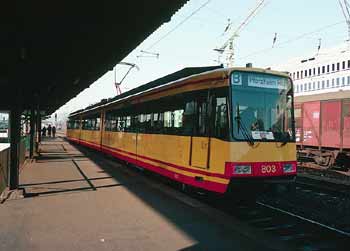 |
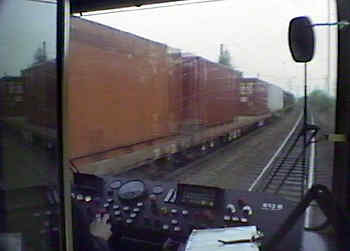 |
|
Germany: Light rail and heavy freight can co-exist on the same tracks very successfully - whether involving a mainline railway which sees other passenger trains too or on a local route which
is solely used by the light rail and freight services. These images come from the Karlsruhe area and include a video-still of a passing freight train as seen through the light rail vehicle's cab.
Track sharing is explored on Track And Route Sharing page. Addtional information in this section comes from these websites:

Passenger trains are derived from the horse-drawn stagecoaches which existed at the time when the railways first began. These early trains usually comprised of a specialist traction device (ie: heavy steam locomotive / engine) pulling a rake of short 4 wheel carriages. At the time there were three 'classes' of travel with 3rd class passengers travelling in what amounted to open wagons without so much as a roof to keep them dry in the rain. 2nd class passengers fared a little better as their carriages had roofs and wooden seats whilst, as is still the situation today, 1st class passengers travelled in the most luxurious conditions. A major innovation was the development of the 'bogie' which is a short 2 axle / 4 wheel (sometimes 3 axle / 6 wheel) unit located at each end of the passenger carriage - these allowed passenger carriages to be much longer than hitherto whilst still being able to negotiate sharply curved tracks. They also gave (give) a significantly smoother quality of 'ride'. Nowadays most - but not all - passenger trains use bogies. Even in the 1990's British Railways was still building some new 4-wheel carriages, mainly for use on uneconomic services which were threatened with closure. This was done in an effort to keep these lines open in the face of a government that was only interested in how cheaply (and not how well) things could be done. Because of their long wheelbase these trains have been known to have difficulty negotiating sharp curves, which to solve requires special works to the rails by the track maintenance people. |
||
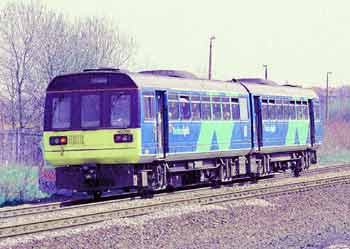 |
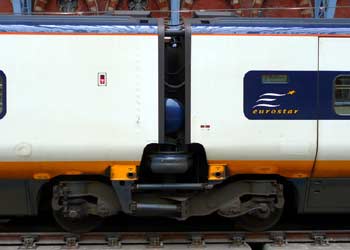 |
|
| These trains feature a single wheel / axle unit towards each end of the carriage. They were built by the former British Railways and were designed to act as basic railbuses to provide a basic minimum service on socially necessary routes. | Most trains nowadays feature two axle / four wheel bogies, usually there is one such unit at the end of each carriage however on a few trains (such as the Eurostar, as seen here) most of the bogies are shared between two carriages. This reduces the train's overall weight, energy consumption and "wear & tear" on the tracks but also means that if one carriage develops a fault the whole train must be withdrawn from service. | |
|
As the railways matured it became usual to vary each train's combination of 1st, 2nd and 3rd class carriages depending on the type of service being provided and passenger demand. For instance: weekday services aimed at the business market would be formed with a higher proportion of 1st class carriages than weekend leisure services. Often the very wealthy would even be able 'hire' a whole carriage just for themselves. Frequently trains would be reformed when calling at intermediate stations, with carriages swapped between trains whilst the passengers remained inside. Some trains also had 'slip' carriages which would be detached from the end of the train on the approach to a station where the train itself would not be stopping. An onboard railwayman would ensure that the slip coach(es) would stop in the station platform and if it was a junction station it (they) might then be added to a local train serving all the stations on that branchline. Especially on branch lines it was also common to operate 'mixed' trains comprising of both passenger carriages and a few freight wagons as this was more cost effective then running individual trains. All this 'chopping and changing' of train formation was done to make life easier for passengers as it saved them the hassle of changing trains. However, whilst these arrangements worked very well they were very labour, time and rolling stock intensive, and therefore expensive to administer. Many towns and cities also hosted urban tramway (literally "street railway") systems and generally these used self-propelled electric tramcars although until electricity became the universal choice some places also used horse-drawn trams and / or special 'street' compatible steam engines pulling a rake of tram trailers. NowadaysNowadays the situation is very different, and with train operator's convenience and economy of operation being the primary deciding factors locomotive hauled passenger trains are becoming increasingly rare in Britain - although they are still common overseas. There are also only two classes of travel - 2nd class was abolished in 1956 and more recently 3rd class was officially renamed 'standard' class. With the exception of special services (such as railway-enthusiast orienteered services) and those on the many heritage / museum lines, modern British passenger trains tend to be formed of semi-permanent fixed rakes of passenger carriages which would only usually be uncoupled when undergoing scheduled maintenance. Frequently there will be special compartments for the train driver at each end of the train as this avoids the cumbersome and time-consuming process of swapping the locomotive from one end of the train to the other at locations where trains must reverse direction (usually but not always terminal stations). The disadvantage with fixed formation trains is their inflexibility. For instance it is rarely possible to simply add an extra carriage (or two) when passenger demand suggests that a longer train is required. In Britain this issue often leads to over-crowding on routes where there is very variable passenger demand and train operators are more concerned with the (admittedly steep) cost of hiring extra carriages (or trains) for than the needs of passengers to travel in greater comfort. The image (below) demonstrates a solution adopted in Switzerland - where the railways are run to attract passengers & not just finance banks - which entails adding a few extra carriages at one end of the train. It should be noted however that passengers who use these "add-on" carriages will be unable to access the rest of the train, eg: for the buffet, as well as be beyond the reach of the roving ticket inspectors and the refreshment trolley crew. |
||
 |
Nevertheless, if compatible rolling stock could be found such could act as inspiration for train operators here in Britain too. A Swiss fixed-formation train with a few extra passenger carriages added at one end to increase the train's overall passenger capacity.Incidentally, these fixed unit trains are of the "push - pull" variety, with a standard locomotive at the other end of the train. Seen in Bern, whilst the station was undergoing major building works. |
|
 |
Although overseas train operators are also (gradually) reducing the number of locomotive hauled passenger trains on their networks many still exist. In this view which was seen at Zürich in Switzerland the locomotive has just detached from the front of the train and pulled forward a little while the station staff prepare what is now the back of the train to be the back of the train! This will include things such as ensuring that the red rear lamps are illuminated and that all cables and hosepipes (such as are used on the braking system and had been connected to the locomotive) are properly located & sealed. |
|
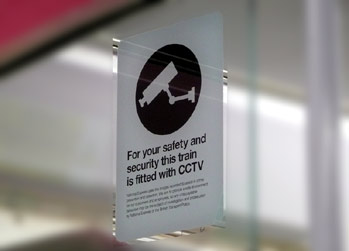 |
Many trains nowadays have video cameras in them watching passengers and recording all events. This is done for our security and protection (so we are told).
It should be remembered that most stations are also monitered in a similar way, plus that in London and many other British towns and cities the streets are monitored in a similar way. Usually the cameras are placed overtly, which means where they will be seen. It remains unknown whether any are also placed covertly, but again, the same applies to the urban streetscene. Perhaps the only thing that those people who wish to avoid being filmed can do is make sure that they stay away from this island nation. |
|
The Various Kinds of British TrainsPush-Pull. These trains still use heavy locomotives but usually it stays at one end of the train. The railway vehicle at the other end of the train will feature a drivers' cab so that for 50% of its journeys the locomotive will be pushing the train - instead of pulling it. Depending on the train company and route being served the railway vehicle with the driver's cab will either be a specially modified passenger carriage or what is known as a 'van trailer' - this effectively being a luggage van equipped with a driver's cab. |
||
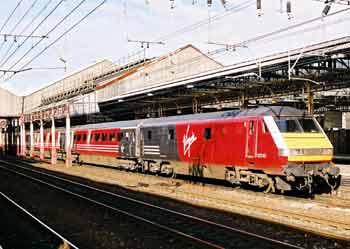 |
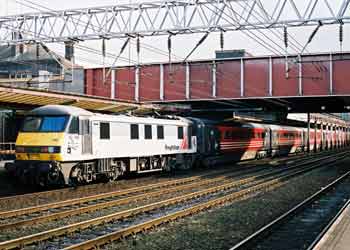 |
|
| Push-Pull train - here with a Driving Van Trailer at the front (left) and locomotive pushing from the rear (right). (Usually these are painted in a livery that matches the rest of the train). | ||
Double-Ended. These trains have a locomotive unit at each end of the train. Examples of this type of trains include the HST (High Speed Train) and the 186mph / 300km/h 'Eurostar' which links London with Paris and Brussels via the Chunnel. |
||
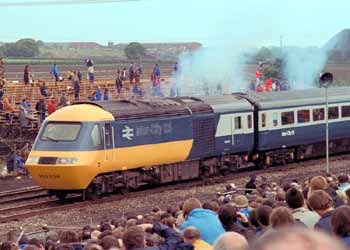 |
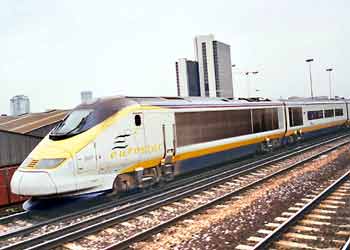 |
|
| The 125mph High Speed Train features identical dedicated diesel locomotive units at each end of the train. Seen here on demonstration at the 1979 Rainhill Trials celebrating 150 years of Britain's railways. | The 186mph Eurostar features identical dedicated electric locomotive units at each end of the train. Seen here whilst operating on third rail power near to London's Waterloo station. Since this image was taken the Eurostar trains have switched to London St Pancras Station and no longer use the 3rd rail electric system, however in all other respects they remain the same. | |
|
Distributed Power Trains. Usually called 'Multiple Units' this type of train is becoming increasingly popular with train operators. Instead of using a specialist locomotive several passenger carriages (typically between 2 and 4 but can be any number) are semi-permanently joined together with the various on-train 'services' being spread throughout the length of the train. This makes it possible for almost the entire trains' length to be dedicated for passenger use. However because the individual carriages that form the train are so dependant on each other there is a disadvantage in that if one of them develops a fault then the whole train could become unusable. At one time diesel 'distributed power' multiple-unit trains would have the engine under only some of the carriages but with many modern designs every carriage is motored and although soundproofing is fitted the noise levels will be similar to those found in a private car. With electric trains both situations are common, depending on the train operators specifications, however even in the carriages which are motored there is a much quieter, smoother ambiance. |
||
 |
 |
|
| A 'two carriage' diesel multiple-unit train. | A 'one carriage' diesel train. | |
|
Single-vehicle. Usually for the quietest rail routes and urban light rail services a single, self-contained vehicle will form a complete train. Whilst it is often possible for several of these vehicles to be coupled together to form longer trains the essential design criteria remains that these vehicles will be capable of operating as single self-contained vehicles. In Britain most of our tram systems operated 'single vehicle' services - one of the few exceptions to this was / is the Blackpool - Fleetwood inter-urban line where some motor + trailer sets still survive. This coastal tramway is the only 'first generation' electric street tramway system on the British mainland which survived into the modern era. All the new systems use articulated trams which are capable of operating as single entities, although with three systems (Manchester Metrolink, Tyne & Wear Metro and London's Docklands Light Railway) multiple unit operation is a design feature - and often occurs. |
||
 |
 |
|
Articulated electric tramcars.
Manchester's Metrolink trams (left) are formed of two near-identical sections joined back-to-back with a flexible connection between them whilst Nottingham's NET trams (right) are multi-segmented. One of the fundamental differences between light rail and the other forms of rail transport is that whereas the operations of traditional railways are always controlled by signalling systems and for reasons of safety they are (supposed to be) hemmed in by high-security fencing with (except at specified crossing points) general public access to the railway right of way prohibited, with light rail there is also the option of "driving on sight" (especially but not exclusively when travelling on the public highway) and the networks are usually 'open' and at stations passengers will frequently be able to cross the line at track level. |
||
 |
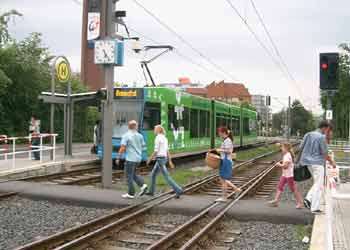 |
|
| The examples shown here come from Nottingham left (where the mainline trains and trams 'route share' - ie: run side-by-side on their own dedicated sets of tracks) and Kassel, Germany right where the trams provide the passenger service on mainline railway tracks which are shared with (occasional) freight trains. | ||
Naming TrainsFor many years it has been practise to give railway locomotives names, perhaps to honour people or places they serve. |
||
 The pantograph on this train is folded down because at this location the train is powered via the third rail - for which an electrical pick-up shoe can be seen next to the wheels on the next carriage. |
When this photograph was taken this class 313 electric multiple unit train was operating on the "humble" (and under-rated) inner suburban "all stations" services
which link west, north and east London, along a route which is electrified by two different electrical systems. It is quite appropriate therefore that it should be named after Nikola Tesla who invented the ac electrical and long-range electric power distribution systems we use today. Tesla was a rival of Edison (who favoured dc power supply systems). |
|
| Tesla invented many, many other things too, including zero pollution energy technologies which, if introduced, would solve our energy and air pollution issues "overnight" - albeit at a price of decimating the stock market values of all the fossil fuel (and nuclear) based energy exploitation and distribution businesses (people would only need a small box in the back garden to collect energy in a similar way to how radios collect radio signals) . This probably explains why both in his time and even today his inventions are still being suppressed in industry and his works expunged from academic textbooks. In the Britain of today Tesla's inventions would also fall foul of the 2004 Civil Contingency Legislation which expressly defines a national emergency as being anything which poses a threat to political, administrative or economic. stability. | ||
Direct links to other Railways pages...
 |
|||||||||||||||||||||||||||||||||||||||||||||||||||||
 |
|||||||||||||||||||||||||||||||||||||||||||||||||||||
 |
|||||||||||||||||||||||||||||||||||||||||||||||||||||
 |
|||||||||||||||||||||||||||||||||||||||||||||||||||||
 |
|||||||||||||||||||||||||||||||||||||||||||||||||||||